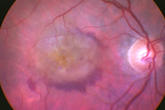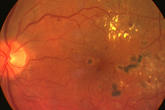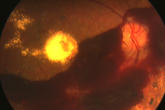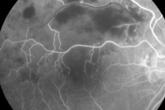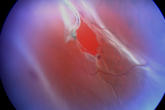www.augenklinik-stralsund.de/en/clinical-characteristics/retinal-disorders
Augenklinik Stralsund, Praxis Dr. med. M. Fechner
D-18435 Stralsund
Große Parower Straße 47
Klinikum am Sund
3rd Floor
Contact
Tel: +49 3831 380002
Fax: +49 3831 380003
The retina is for the eye what the film is for the camera; the retina generates the pictures which are – via the optic nerve – passed on to the brain and perceived as such by it.
The retina consists of many million sensory cells (photoreceptors) which increase in numbers from the outside to the centre; the centre of the retina (macula) has the highest density of sensory cells.
a) Age-related macular degeneration (AMD)
According to its extremely high efficiency, the centre of the retina is especially sensitive and, not rarely, exposed to an age-related process of wear (dry macular degeneration), which in most cases, due to a decline of sensory cells, leads to a more or less perceptible diminishing of visual acuity; however, as a rule, it does not jeopardize the reading capability as such. So far, no cure is known that would surely be effective against the dry macular degeneration.
In certain cases, the AMD takes a different, more aggressive course (exudative macular degeneration), in which blood components are issued under and into the centre of the retina causing a loss of its function within a few weeks' time. The exudative AMD may be heralded by distorted vision, i.e. that the patient does not see straight lines as straight any longer; later on, a zone of blurred vision is perceived in the centre of the visual field until eventually only a grey spot is to be seen at the place one is just trying to look at.
When it has freshly occured , the exudative AMD is an emergency; patients who notice the aforementioned symptoms should see an ophthalmologist the next working day and insist on an examination of the ocular fundus with the pupil dilated, because the exudative AMD is treated the better the sooner it is diagnosed.
Various methods of treatment are available:
| - | laser coagulation |
| - | transpupillary thermotherapy |
| - | intravitreal injection of vessel-sealing medication (IVOM), representing by far the most modern and effective therapeutic principle |
The decision about the type and duration of this chronic disease’s treatment has to be founded upon a thorough ophthalmological examination, which comprises a threedimensional rendering of the macula by a laser scanner (optical coherence tomography, OCT). Alas, use of this modern and most important examination tool is not yet covered by all health insurances, in which case it has to be paid for privately.
b) diabetic retinal disorders; other circulatory disturbances
Diabetes mellitus is a disease which may detrimentally affect the entire body. With the disease advancing, the eyes are disproportionately often affected; after fifteen years of duration of the disease, every second diabetic has diabetic retinal findings (diabetic retinopathy).
There are two distinct pathogeneses, though often overlapping and sometimes negatively complementing each other:
| - | in its original meaning, the diabetic retinopathy affects the retina as a whole and distinguishes itself by circulatory disturbances; some blood vessels become porous and leak, others occlude. If it comes to a decreased blood circulation of major regions of the retina due to the disease, new blood vessels grow onto the retina (neovascularizations), which may cause spontaneous haemorrhages into the eye, a retinal detachment and, finally, complete blindness of the eye. |
| - | the second pathogenesis affects the centre of the retina (diabetic maculopathy); due to either the flow of humour out of diseased blood vessels or their occlusion, a swelling of the macula occurs with a progressive loss of visual acuity. Nevertheless, diabetic maculopathy alone never causes complete blindness. |
Diabetic retinal disorders are diagnosed by endoscopy of the ocular fundus, by fluorescein-angiography to make disturbances of the retinal blood flow visible, and by optical coherence-tmography (OCT) to measure the degree of retinal swelling as an indicator of the severity of vascular disorder.
The best treatment of a diabetic retinal disorder is, first of all, the taking of preventive measures; in this connection, the keeping of blood sugar and blood pressure on an optimal level as well as the renunciation of nicotine play the most important role. If a retinopathy has occured that needs treatment, laser coagulation of the diseased retinal regions is mostly the next measure; if this does not stabilize the eye sufficiently, cryocoagulation (a treatment of the retina by external application of cold) or a removal of the vitreous body (vitrectomy) may have to be resorted to as further operative procedures.
In the majority of cases of central retinal swelling (macular edema) with reduced vision repeated intraocular injections of vessel-sealing medications (IVOM) have shown to be an effective therapy.
c) other circulatory disturbances of the retina
Clogging of arterial vessels (branch- or central retinal artery occlusion) cause - depending on the size of the retinal region affected – a sudden, painless narrowing of the visual field up to the complete loss of sight. As a rule, a treatment is only sensible if it is carried out within the first 12 hours after the occurance of the symptoms. In case of respective complaints, it is therefore absolutely necessary to go to an ophthalmologist immediately. Every minute is precious!
Common consequence of venous occlusions affecting the center of the retina is a retinal swelling (macular edema) with decreased visual acuity; this problem is frequently best addressed by intraocular injections of vessel-sealing medications (IVOM).
Clogging of venous vessels (branch- or central retinal vein occlusion) become less acutely perceptible and, as a rule, do not cause a complete loss of function of the affected retinal region. Often just a relative narrowing of the visual field, a grey shadow or a reduced visual acuity is perceived. However, in these cases too, an immediate presentation at the ophthalmologist's should take place. Not infrequently a long-term subsequent treatment is necessary in order to prevent late complications, which may occur even after years.
d) retinal detachment and related problems
The retina lines the inner surface of the eye like a wallpaper, is not attached or stuck to the inner surface of the eye though, but is actively held by a vacuum which is generated by the adjoining cells.
Occasionally, the retina breaks in its peripheral regions – spontaneously and without obvious cause. This process can become noticeable by the perception of heavy flashes or by the occurence of numerous black spots which seem to swim around in front of the eye.
Now, due to the retinal break, the water contained in the interior of the eye flows behind the retina; the negative pressure holding it gets lost and it begins to detach itself from its basis round the break. Within a few days' time, this process may result in a complete detachment of the retina.
As a detached retina cannot see any longer, a dark shadow or visual field defect corresponding to the size of the detached retinal region is perceived.
In case of the occurrence of one or more of the aforementioned symptoms, it is important to go to an ophthalmologist immediately, since here, too, the treatment is the easier and the more successful the sooner the problem is addressed.
If only a break has emerged, but the retina not detached yet, often a simple laser coagulation will be sufficient.
If, however, the retina is already detached in parts or completely, the eye has to be operated: in the direction of the retinal break, a lump of the inner surface of the eye is caused either by a silicone foam seal, which is sewed onto the outer layer of the eyeball, or by an encircling band, which is laid around the eye. This bulge occludes the hole in the retina, which can lay itself on the inner surface of the eye again. In complicated cases, these techniques will not be sufficient; then it is necessary to close the retinal break in a large-scale operation from the inside of the eye using air, gas or silicone oil.


